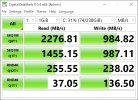I have a HP Pavilion X360 14m-dw1023dx laptop with a Core i5-1135G7 CPU.
According to HWiNFO64, this CPU has a RST VMD Controller with a PCIe 2.0 bus (see attachments) which is connected to a Samsung MZVLQ256HAJD-000H1 PCIe 3.0 x4 NVMe M.2 SSD.
Since PCIe 2.0 x4 is limited to 2.0 GB/s, how is it possible that the SEQ1M Q8T1 sequential read speed reported by CrystalDiskMark exceeds 2.2 GB/s?
This CrystalDiskMark result is theoretically impossible from a PCIe 2.0 x4 bus, but is easily achievable from a PCIe 3.0 x4 bus.
Is HWiNFO64 reporting erroneous information about the actual PCIe bus used by the RST VMD controller?
According to HWiNFO64, this CPU has a RST VMD Controller with a PCIe 2.0 bus (see attachments) which is connected to a Samsung MZVLQ256HAJD-000H1 PCIe 3.0 x4 NVMe M.2 SSD.
Since PCIe 2.0 x4 is limited to 2.0 GB/s, how is it possible that the SEQ1M Q8T1 sequential read speed reported by CrystalDiskMark exceeds 2.2 GB/s?
This CrystalDiskMark result is theoretically impossible from a PCIe 2.0 x4 bus, but is easily achievable from a PCIe 3.0 x4 bus.
Is HWiNFO64 reporting erroneous information about the actual PCIe bus used by the RST VMD controller?

